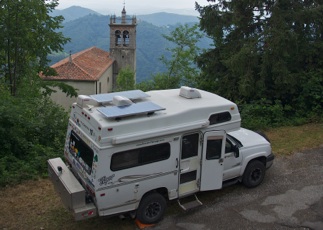
Our system consists of two 120 watt solar panels, two 6 volt AGM golf cart batteries, a 2000 watt inverter/charger, and a Xantrex (Trace) 500 meter to monitor the system. We find this system to be more than adequate in most conditions. We watch a DVD movie most every night, helped by the Toshiba 12v flat screen TV/DVD that our Tiger came with; this TV draws only 2.5 amps, so watching a movie is no more draw than running a couple of incandescent lights for reading. We understand Toshiba stopped importing this TV, and Tigers are now coming with 110 volt TVs powered by a small inverter. This system will use more power. Twelve volt TVs with built in DVD players are currently available from other manufacturers; one source for information on these units is www.roadtrucker.com.
We also have two laptop computers, and running the inverter to work on them all day on a rainy day can put a crimp in things. In these conditions, we try to balance use of the laptop batteries with the coach batteries and occasional generator use. Even on cloudy days we get some solar, enough to keep the batteries up; especially since we seldom stay in one place more than a day or two and the batteries charge while we drive of course. It is only when we combine not driving with overcast weather and intensive computer use that we run into situations where we need to run our generator in order to keep the batteries charged.
In our Tiger, watching a movie, using the inverter to heat up coffee in the microwave, lights, water pump, etc. uses about 20 amp hours over night. Add in the 12v refrigerator operation, fans in hot weather or more microwave use and our overnight draw can be up to 45-55 ah. In sunny weather, the panels will charge at a rate of about 15 amps, on cloudy days that will drop to 4-8. At about 90% charge, the rate tapers off considerably. Still you can see that by the end of the day the batteries will be pretty much back to zero unless you've had significant draw during the day. With the original equipment converter/charger, running the generator to charge batteries was pretty inefficient as it only charged at about 8 amps. With our new 2000 watt inverter with its more sophisticated 100 amp charger it is a much different story and even just one hour of generator use while Kathy bakes something in our microwave/convection oven results in a significant improvement in the battery status.
To me, the key to operating any RV electrical system for extended periods is a good meter that allows you to tell what each item draws and what your cumulative draw is for any given time period. When we were setting up our first solar system in 2002 I asked what the best available meter was and it was the Trace 500. When we were setting up the Tiger in 2007, the answer was still the same. It's a great meter and tells me everything I need to know about drain and charge rates as well as the condition of our batteries.
A couple of the other things you can do to reduce your electrical needs (in addition to the catalytic heater and Fantastic Fans covered elsewhere on this page) are to use a french press rather than an electric coffee maker to make coffee; and get LED conversion light bulbs for your most frequently used fixtures - power draw is less than 10% of the original incandescent bulbs.
Note: While in the US in 2009, we replaced the original 3-way gas/electric refrigerator in our Tiger with a more efficient all electric 12/110/220 volt unit. This unit draws about 3.5 amps when running, or about 35-40 amp hours per 24 hours. This change has roughly doubled our 24 hour electrical usage, but our system has been able to handle the increased demand with no problem. The advantages of this move are a much more efficient refrigerator and a drop in propane use to less than half of what it was before.
Other Questions:
Do I need a generator? For us, the generator is important for several reasons. For someone else, it may not be as important. While having a generator can be very useful, it takes up space in your storage compartments that could be used for other items, so getting along without it can have some advantages.
A generator in an RV serves basically two functions; it provides power to appliances or systems when the vehicle is not plugged in to shore power and it can be used to recharge batteries. As discussed elsewhere in these pages, when traveling in other countries, even when you have the opportunity to plug in, the available power may not be adequate to run your systems properly depending on your equipment. Another consideration in evaluating your need for a generator is your camping style. If you intend to stay in campgrounds most of the time, and if the requirements of your particular appliances can be met by local shore power, then you probably do not need to carry a generator. In most countries, we simply do not stay in campgrounds, so for us plugging in isn't in the cards anyway. A separate consideration in regard to using a generator is that they all make some noise and some of them can be quite noisy. We try to be very sensitive about noise (although the Tiger’s Onan unit is pretty quiet) and seldom use our generator if other campers are nearby. Our preference is to park with no one else in sight, and only run the generator when we are alone. We actually use our generator fairly seldom, but when we need it we’re glad to have it.
We use an all electric microwave/convection oven. Kathy loves them. In the absence of good 110 volt, 60 cycle electric to plug into, the only time we can use the oven is when we run the generator. The microwave works fine on the inverter (this is the reason we have a 2000 watt inverter), but using the oven this way would rapidly drain the batteries. The microwave also works fine on 50 cycle electric after we've converted it from 220 to 110 with our portable transformer, while the oven does not. We do not have a rooftop air conditioner, but if you do, the same limitations would apply. When the weather goes south on us we'll often stop somewhere, generally not in a campground, and sit around for a day or two catching up on computer work. With no sun, the additional load of keeping the laptops going with the inverter and not doing any driving, the batteries will gradually run down. Depending on how thick the cloud cover is, our solar panels can manage the load for one or two days, but ultimately we'd need to either drive or run the engine in order to charge the batteries. That's when we'll fire up the generator and fix something in the oven for dinner, or make cookies or banana bread or whatever. Several birds get taken care of all at once that way and we're not forced to move before we want to or idle the vehicle’s engine for extended periods in order to charge the batteries.
So, whether or not you need a generator pretty much comes down to two things. Your cooking style, i.e. what type of oven you have, if any; and how comfortable you are in terms of backup systems when you are parked away from other resources. If your cooking preferences call for no oven or a gas oven and if you do not have a rooftop air conditioner you could surely do without the generator, running the engine to recharge house batteries when necessary. If that is the plan, some engines have the ability to mount a second alternator and if yours will allow that it would be a good idea as this would increase the output from the alternator(s) and shorten the time the engine must be run. For us, the generator is essential for the use of our convection oven and we feel that it is also an important part of our self containment ability. Since we have the generator for battery charging when needed, I have never felt the need for the second alternator as our house batteries recharge fairly quickly (i.e. at a charge rate of about 25 amps) on our single alternator when we're driving.
How important is small size? We really like traveling in a vehicle that is just as small as possible. Wherever we are, we frequently travel on small secondary roads, either paved or unpaved, and must deal with encroaching tree limbs, rock overhangs, passing vehicles, or just plain narrow conditions. In rural areas of many countries, the road between towns becomes the main road through the center of town and that can be really interesting, especially on market day. We also find ourselves all too often needing to turn around for any number of reasons. Obviously, the larger the vehicle, the more it will limit your ability to go where you want to go. Of the three basic vehicle dimensions, Kathy and I would rate width as being the most frequent limiting factor in determining where we can go or whether or not we get stuck somewhere and have difficulty getting out of a situation. Following that would be turning radius, or basically wheelbase; then height, with overall length being least important. To some degree, longer overall length generally equates with longer wheelbase, so it can be hard to separate the two. However, our choices to carry our spare tire on the front of the coach and to mount exterior storage boxes at the rear are both ways that we increase our storage carrying ability while maintaining the shortest wheelbase and therefore turning radius. It may be tempting to go with a larger vehicle, but if you really want to go to out of the way places, you will pay for that extra size constantly.
Do you need an air conditioner? We opted to not have one, instead we have two fantastic fans in the ceiling. We also swear by their Endless Breeze moveable unit; basically the same fan in a table top unit. This provides great circulation at minimal electrical usage and you can set it up right on the table in front of you. The Fantastic Fans use 1.2 amps on low speed, which is generally all we need to run them. This is the same usage as one of the incandescent bulbs used in RV light fixtures, so we can run them all the time if need be. We have Maxx Air covers on both fantastic fans so we can run them in the rain. Sure an A/C can be handy, but only if you are somewhere with good electrical power available. Even in the states, we are seldom in a campground with electricity, so for us deleting the weight and roof space of an A/C was a no brainer. When traveling in other countries, you will seldom have the 30 amps of power necessary to run a roof air conditioner. Add in the loss of interior headroom and the limited space available on the roof of a small coach for solar panels and we've never regretted going without the A/C. Someone with a different camping style might make a different decision.
Diesel vs. Gasoline? In a small motorhome, Diesel will give approximately 50% better fuel economy; we average 13-14 mpg in all conditions, with 16+mpg in normal highway driving. A gas engined Tiger or similar unit will be in the 8 to 10 mpg range. In Canada, Mexico and most other countries diesel is cheaper than gas, sometimes by as much as $1 per gallon. In the US, diesel is more expensive. However, even when gas is cheaper than diesel, the better fuel economy of the diesel still gives lower operating costs. In Europe, with its much higher fuel costs, our monthly average for fuel in 2012 was $900 per month; with a gasoline engined Tiger it would have been $450 per month higher than that, so yes it does make a difference. Diesels are considerably more expensive initially however, and are a bit noisier, although not nearly as much as they used to be; diesel is also safer as it is much less flammable than gasoline. At higher elevations, the diesel's turbo gives much better performance than a gas engine. We like diesel, but there are many considerations. One main one for Mexico and other Latin American countries is the current availability of the Ultra Low Sulphur Diesel fuel now mandated in Europe, the US and Canada. Our Tiger is an '07 Classic model Chevy and does not require the newer fuel, while all newer models do. Only right at the end of our year and a half in Latin America in mid 2009 did we begin to see ULSD being offered near Buenos Aires, and then it was at a significant increase in price over the still available regular diesel fuel. It will almost certainly be many years before ULSD is commonly available worldwide, so where you will travel must be a factor in any decision regarding which engine to buy.
Minimizing/Eliminating need for propane? In the US and Canada, propane availability is never an issue, but when traveling in other countries, having access to propane supplies varies from being even easier than in the US to being very difficult. The main uses for propane in an RV are heating, refrigeration and cooking. While it is possible to eliminate propane systems entirely, utilizing diesel furnace, water heating and cooking systems as well as a diesel or gas generator in place of the propane powered generator on our Tiger, these systems are expensive and are not offered by most manufacturers. When available, they are generally only found in vehicles that are considerably more expensive than a Tiger. One manufacturer I’ve seen quotes a premium of over $6,000 for all diesel appliances (furnace, cooktop, water heater, diesel generator).
Provan is now installing AC/DC refrigerators that do not use propane and we have made that change to our unit as well. This is a huge help in minimizing propane use; careful analysis of our own records shows that with the new refrigerator, our propane use is now less than half of what it was before. One advantage of staying with an LP (propane) based system is that an LP generator typically requires less maintenance than a comparable gasoline model while diesel generators are larger, heavier and considerably more expensive. While getting propane can be difficult in some countries, most of the available vehicles you will be choosing from do utilize propane, so it will probably always be a part of your system. We have had good success dealing with the propane requirement by finding ways to minimize our usage and thereby lessening the need to refill the tank frequently. Then, when it is time to get propane, online research into availability of supplies and necessary adapters has always allowed us to manage quite nicely. Our Our Vehicle page has some useful links to discussions of these topics. Update 2013: We have now traveled in our Tiger in 54 countries on five continents. In only two of those countries, Colombia and Morocco, was propane availability an issue. We do not consider needing propane to be a disadvantage.
Eliminating the Furnace? We do use our furnace occasionally, but prefer to use a catalytic heater in cold weather. A standard RV furnace is noisy and puts a heavy load on batteries if allowed to run off and on all night long. The catalytic heater plugs into a quick disconnect in the propane line and provides a silent heat with no electrical drain (no fan). If we run the catalytic heater during the night it keeps the interior warm; if we have not had it on and wake up to a cold morning, the original equipment furnace warms things up in just a few minutes use, so both systems have their place. While we don’t specifically “winter camp”, we've seen overnight freezes even in Florida and Texas and like to travel in the mountains a lot where even in mid summer you can have cool evenings. When you also consider that shoulder seasons make for much more enjoyable travel in most areas, I would never advise anyone to travel without at least one means of heating the living space.
2wd vs 4wd? This depends entirely on where you like to travel. We love having the 4x4 available even though we don't climb rocks or go off road at all. We just like to feel free to take any road that appeals to us, paved or not, and have never regretted opting for four wheel drive.
Batteries under the coach vs. under the couch inside the unit? The under floor location Provan uses is actually an excellent location for the batteries as it keeps their weight low and utilizes space that would otherwise be wasted. Maintenance of the batteries when installed in this location is difficult however. I installed a remote filler system for adding water to our original batteries and that worked well although I had to just trust the system as there was no practical way to actually check the batteries. In 2009 I replaced the original wet cell batteries with AGM units. That should be a perfect solution with zero maintenance needed. The downside of this move is cost as the batteries were about $270 apiece, about three times the price of the wet cells. As to moving the batteries to a more convenient location, we utilize every inch of interior storage in our Tiger and I would not give up any of it for batteries. Provan now offers AGM batteries as an option.
Concerns about getting from front to rear in the Tiger. I'm 6' and 260 and it works ok for me. It's tight for us big guys, as is any small RV, and I generally choose to go around; but, I can go back and forth if I want to. Kathy scoots back and forth frequently; we really appreciate having that ability in our Tiger and consider it to be a very important feature.
Eliminating Awning? We use ours quite a bit even though we seldom actually sit outside under it. We use it mostly for shading the coach from the sun to reduce interior temperatures and have often thought about adding one to the driver's side as well for that purpose.






